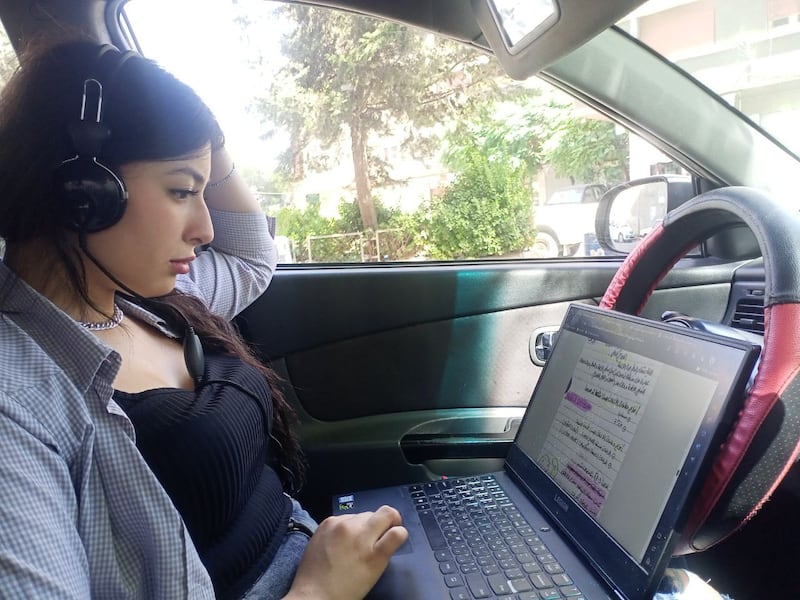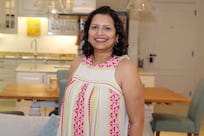When Heba Jamjoum, a Jordanian sign-language interpreter, was pregnant with her now six-year-old son, she became aware of a lack of Arabic educational content for deaf children.
Five years later, in 2022, Ms Jamjoum and her hearing-impaired husband, Mamoun Oudah, a graphic designer, launched an animation project named after their two children, Tameem and Reem, to help address that lack of content.
They began creating cartoons and posting them on YouTube to help teach sign language to deaf children.
While awaiting the birth, Ms Jamjoum said: “It occurred to me how little educational content is available for Arab deaf children.
"And even though our children are not deaf, we decided we wanted deaf children to learn sign language and Arabic."
About 21 million children in the Middle East and North Africa live with some form of disability. Often, their condition strips them of basic rights and places limitations on their prospects and opportunities.
Barriers, including support for children with disabilities in mainstream public education and community schools, lack of teacher training and inaccessible and rigid curricula are some of the reasons for this reality.
But now, initiatives are beginning to spring up across the region, designed by people using their experiences of similar challenges to slowly chip away at the barriers that may have held them back.
Mr Oudah is one of those people.
Tameem and Reem is the first project of its kind in the Arab world. Since its launch in October 2022, the channel’s brightly coloured characters have attracted more than 3,500 subscribers on YouTube. Mr Oudah handles the animation while his wife takes care of the interpretation.
Their children bring the voices to life.
The journey was not easy, Ms Jamjoum says. She says her husband spent four years learning how to create and animate characters before launching pages on YouTube, Facebook and Instagram.
“We had limited resources, a small team, and lack marketing and management skills,” she tells The National.
"Over time, we will build a team, produce quality content, register the project as a company to purchase publishing rights for children's books and collaborate with relevant stakeholders."
A long way to go
About 11 per cent of Jordan's 11.3 million population suffer from some form of disability, according to a 2015 census that officials at the Higher Council for the Rights of Persons with Disabilities say is the most recent count.
A report in September 2022 issued by Handicap International (HI) said 79 per cent of children with disabilities are excluded from any form of education in Jordan, largely because of widespread negative attitudes to disabilities by families.
Special education teacher and disability rights activist Esraa Dawood says most teachers cannot use sign language.
“Schools are ill equipped to accommodate deaf children and the Ministry of Education does not deploy special education teaching methods,” she said.
That lack of experts to monitor the progress of deaf children in schools further affects their academic and professional lives, she says.

Syrian Wissam Kanakria, 31, lost his eyesight at age 12 after contracting Leber’s disease, a rare disorder typically found in young boys that results in progressive visual loss due to optic nerve damage.
In 2019, he founded Read With My Eyes, an initiative that provides audiobooks for blind students.
Since then, the initiative has recorded more than 200 gigabytes of free audio content, delivered in mp3 format, reaching more than 600 people of all ages in Syria and beyond, offering a range of material and catering to special requests for specific books.
"Today, I see with the eyes of 800 volunteers," Mr Kanakria says.
A year ago, business administration student Jawahir Fakhro, 21, transformed her study into a makeshift studio and her car into a quiet haven for her volunteer work – recording audiobooks for the blind.
Dedicating at least four hours a week to recording audio study material, Ms Fakhro has since put voiceovers to 30 lectures, covering subjects from psychology and sociology to religious studies.
"Humanity is to volunteer without expecting anything back, bringing happiness to those in need, ultimately benefiting us all," she says.
Salem Suleiman, director of the Noor Institute for the Blind, says there are no accurate statistics on the number of blind people in Syria.
About 3,000 blind people were recorded in north-west Syria, according to statistics gathered by local aid groups.
The latest figures from the Syrian Central Bureau of Statistics, from 2018, show that 9 per cent of Syrians aged five and above experience vision difficulties, with the highest rates in the cities of Suwayda and Damascus.
“The number of blind people spiked at the height of the armed conflict,” Mr Suleiman says. “This made many families hesitate to enroll their blind children in school.”
In war-torn Syria, children with disabilities have been especially hard hit by the conflict. A 2022 Human Rights Watch report examined how they face disproportionately higher risks because of poverty, a lack of access to humanitarian assistance and harm to mental and physical health, among other reasons.
But even when they do access education, Mr Kanakria says, they face other challenges.
“There is a lack of suitable educational and scientific content, exams do not accommodate the blind and converting textbooks to Braille is expensive,” he said.
Nineteen-year-old Israa could not agree more.
“They were literally my eyes,” says the University of Damascus student of Arabic about the Read With My Eyes initiative.
This article was written in collaboration with Egab.






